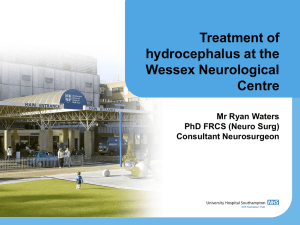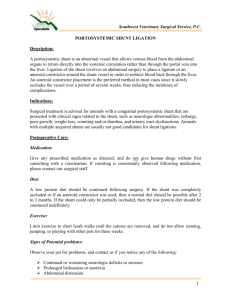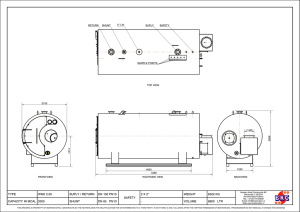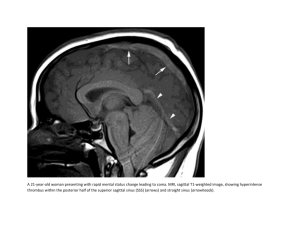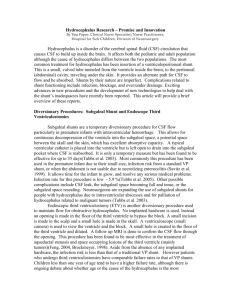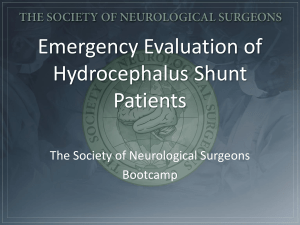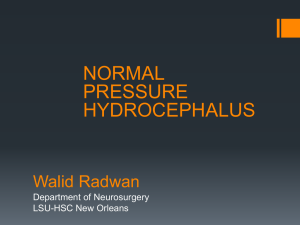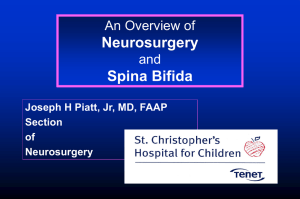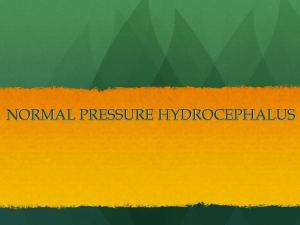The treatment of hydrocephalus
advertisement
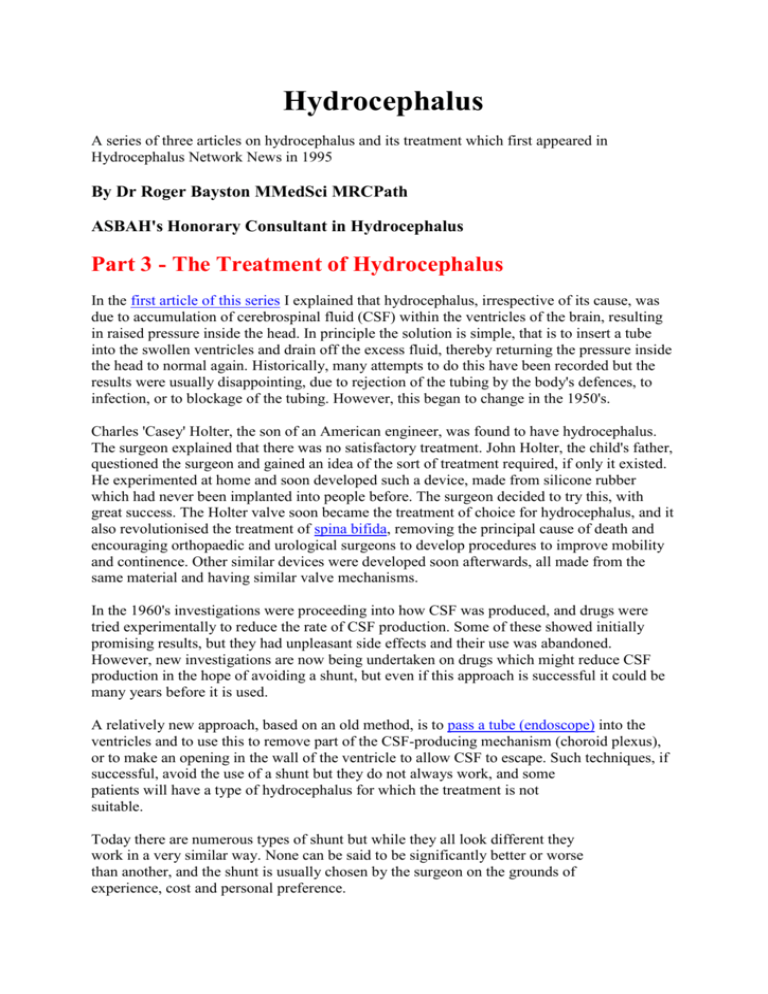
Hydrocephalus
A series of three articles on hydrocephalus and its treatment which first appeared in
Hydrocephalus Network News in 1995
By Dr Roger Bayston MMedSci MRCPath
ASBAH's Honorary Consultant in Hydrocephalus
Part 3 - The Treatment of Hydrocephalus
In the first article of this series I explained that hydrocephalus, irrespective of its cause, was
due to accumulation of cerebrospinal fluid (CSF) within the ventricles of the brain, resulting
in raised pressure inside the head. In principle the solution is simple, that is to insert a tube
into the swollen ventricles and drain off the excess fluid, thereby returning the pressure inside
the head to normal again. Historically, many attempts to do this have been recorded but the
results were usually disappointing, due to rejection of the tubing by the body's defences, to
infection, or to blockage of the tubing. However, this began to change in the 1950's.
Charles 'Casey' Holter, the son of an American engineer, was found to have hydrocephalus.
The surgeon explained that there was no satisfactory treatment. John Holter, the child's father,
questioned the surgeon and gained an idea of the sort of treatment required, if only it existed.
He experimented at home and soon developed such a device, made from silicone rubber
which had never been implanted into people before. The surgeon decided to try this, with
great success. The Holter valve soon became the treatment of choice for hydrocephalus, and it
also revolutionised the treatment of spina bifida, removing the principal cause of death and
encouraging orthopaedic and urological surgeons to develop procedures to improve mobility
and continence. Other similar devices were developed soon afterwards, all made from the
same material and having similar valve mechanisms.
In the 1960's investigations were proceeding into how CSF was produced, and drugs were
tried experimentally to reduce the rate of CSF production. Some of these showed initially
promising results, but they had unpleasant side effects and their use was abandoned.
However, new investigations are now being undertaken on drugs which might reduce CSF
production in the hope of avoiding a shunt, but even if this approach is successful it could be
many years before it is used.
A relatively new approach, based on an old method, is to pass a tube (endoscope) into the
ventricles and to use this to remove part of the CSF-producing mechanism (choroid plexus),
or to make an opening in the wall of the ventricle to allow CSF to escape. Such techniques, if
successful, avoid the use of a shunt but they do not always work, and some
patients will have a type of hydrocephalus for which the treatment is not
suitable.
Today there are numerous types of shunt but while they all look different they
work in a very similar way. None can be said to be significantly better or worse
than another, and the shunt is usually chosen by the surgeon on the grounds of
experience, cost and personal preference.
Originally shunts were inserted so that a tube drained CSF from the ventricles in the brain,
through the valve and through another tube into a vein in the neck and then into the heart
(ventriculo-atrial or VA shunt). While these are still used, most nowadays drain the CSF into
the abdomen (ventriculo-peritoneal or VP shunt) and the bottom tube can be felt over the ribs.
Despite all these developments, shunting can have complications. These can be divided into
under-drainage, over-drainage and infection.
Under-drainage, in which the fluid is not removed quickly enough and the symptoms of
hydrocephalus return, is one of the commonest problems. It is usually due to blockage of the
upper or lower tubes of the shunt tissue, though it can be due to the shunt breaking or its parts
becoming disconnected from each other. It is rarely due to the valve itself, which usually
continues to function in the same way for years. Pressure may sometimes build up rapidly,
resulting in loss of consciousness, and treatment is required as an emergency. However, in
most cases the onset is more gradual, and can follow a minor illness such as a cold.
Headaches increase in frequency and severity, often worse on waking in the morning.
Vomiting and dizziness also occur, and sometimes other symptoms which vary from patient
to patient. In these cases the parents or carers will be able to recognise the symptoms from
previous episodes. Specialist hospital staff are now fully aware of the various presentations of
'blocked shunt' but non-specialists and family doctors may not be.
Shunt blockage can also have much more subtle consequences and the headaches may be
infrequent, the main problem being behavioural deterioration. In older children this might
take the form of increased irritability, 'laziness', poor or disruptive school performance or
even more antisocial activity. This may be very difficult to distinguish from the usual teenage
angst but, if there is any reason to suspect that the deterioration in behaviour is not 'normal',
assessment must be carried out by an experienced educational psychologist with a knowledge
of hydrocephalus. The basis for the effects of high CSF pressure have been explained in the
previous article. If the shunt is to blame, a dramatic improvement can result from appropriate
treatment, though this form of shunt problem is particularly difficult to diagnose. It may be
necessary to monitor CSF pressure, often over 24 hours. This can be done using a pressure
monitor in the scalp connected to a recorder. In this way pressure can be recorded during
sleep and changes in posture. Scans to show the size of the ventricles are particularly useful if
they can be compared to previous scans, though in someone with clear symptoms of either
high or low CSF pressure they may also serve to support the diagnosis.
In the case of over-drainage, the shunt allows CSF to drain from the ventricles more quickly
than it is produced. If this happens suddenly, usually soon after the shunt is inserted, then the
ventricles in the brain collapse, tearing delicate blood vessels on the outside of the brain and
causing a haemorrhage ('subdural haematoma'). This can be trivial or it can cause symptoms
similar to those of a stroke. The blood may have to be removed, and in some cases if this is
not done it may be a cause of epilepsy later. If the overdrainage is more gradual, the ventricles
collapse gradually to become slit-like ('slit ventricles'). This often interferes with shunt
function causing the opposite problem, high CSF pressure, to reappear, but unfortunately the
slit ventricles do not always increase in size again, producing the situation where there is very
high CSF pressure with headache, vomiting etc but very small ventricles on scan.
The symptoms of over-drainage can be very similar to those of under-drainage though there
are important differences. Headaches, dizziness and fainting occur and are often worse after
getting up from lying down, whereas the headaches caused by high CSF pressure are often
worse on waking, before rising in the morning. However the best way to diagnose the
problem, having recognised that one exists, is to measure the CSF pressure over 24 hours.
Underdrainage can be caused by blockage of the shunt tubing either at the top end, by tissue
plugging the entry holes or by the position of the tube changing; or at the bottom end, by
tissue in the abdomen sealing off the drainage tube. In VA shunts blockage can occur at the
bottom end as the child grows, and a revision operation is sometimes necessary to lengthen
the shunt at the age of 12-18 months. Over-drainage is a more difficult problem. There is no
clear relationship between the type of valve (high or low pressure) or the brand, and overdrainage. A change of valve to a higher pressure cannot be relied upon to cure it, though it
appears to do so in some cases. Studies have shown that the use of an 'antisyphon device', a
small button inserted into the shunt tubing, will often solve the problem, but this does not
always work. Some shunts have these built-in, but neurosurgical opinion varies as to whether
they should be used. To change a valve pressure it is necessary to remove the valve and insert
another. A relatively new shunt, the 'programmable' or adjustable shunt, is intended to allow
adjustment of the working pressure of the valve without operation. The valve contains
magnets which allow the setting to be changed by laying a second magnetic device on the
scalp. This is undoubtedly useful where the need for a valve of a different pressure arises, but
the adjustable valve is no less prone to over-drainage than any other and it cannot be used to
treat this condition.
It has long been believed that a raised protein level in the CSF will block the shunt, and in
babies with hydrocephalus shunting has been delayed until the protein level has fallen. Recent
research has shown that a raised CSF protein level has no ill-effect on shunt function, nor
does it increase the risk of infection, and there is now no reason to delay unless blood is also
present.
The third complication of CSF shunting is infection. This is almost always due to bacteria
from the skin getting into the CSF or shunt at operation, and is remarkably difficult to
prevent. Antibiotics have not been shown to be of benefit for this purpose, and other measures
often have only a temporary effect, though obviously the care and expertise of the surgical
team is one of the most important factors in reducing the rate of infection to a minimum.
However, even in the best of hands infection still occurs. One of our recent developments has
been a process which makes shunts resistant to bacterial infection, and we hope that the
current clinical trials will show that it is capable of reducing shunt infection by more than
80%.
In VP shunts infection will usually show itself within a few weeks or months of operation as a
shunt blockage, though there may also be occasional fever and abdominal pain. Redness and
swelling may be seen over the lower shunt tubing. It is important to distinguish between
blockage of the VP shunt due to infection and that from other causes as the treatment is
different. In VA shunts blockage due to infection is rare, and many months or years can go by
before the infection becomes apparent. During this time there will be tiredness, irritability,
poor appetite, various aches and pains, skin rashes and other signs but all of these can be due
to common disorders. A blood test will usually reveal anaemia and this is an important
though, on its own, not a specific indication of infection. Blood cultures and even CSF
cultures can be negative. Later, blood may appear in the urine due to secondary kidney
damage.
While shunt infections can sometimes be very easy to diagnose, they are often difficult and
any delay increases the chance of further damage. Special blood tests have been developed
which promise to allow a reliable diagnosis to be made early, but these are not in current use
due to lack of funding.
VA and VP shunt infections are both treated in the same way. Until recently, this involved
operations, long periods in hospital and disappointing relapses before a new 'clean' shunt
could eventually be inserted. We have recently developed a new approach which shortens the
time taken to treat most shunt infections to 7-10 days, with a very low relapse rate, and this is
gradually being adopted by others. Unfortunately the infected shunt still has to be removed,
though in future it may be possible to treat these infections successfully without taking out the
shunt, and research into this aspect is continuing.
Though complications of shunting remain an important problem in the treatment of
hydrocephalus, I hope I have managed to explain some of their mysteries, and to show that
solutions are being found.
